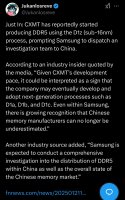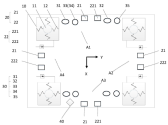broadsword
Brigadier
The complete SCMP report of the Harbin EUV light source via Emperor of CDF. 2026 looks too optimistic though.
How China’s award-winning EUV breakthrough sidesteps US chip ban
Story by Zhang Tong • 22h • 4 min read
As US restrictions continue getting tougher, Chinese researchers are coming up with innovative approaches to chip manufacturing
New approaches in the development of extreme ultraviolet (EUV) lithography are being pioneered by Chinese scientists, paving the way for the mass production of advanced semiconductor chips as researchers race to sidestep the strict sanctions put in place by the United States.
And one such project from the Harbin Institute of Technology was recently awarded first prize at the Harbin Provincial Innovation Achievement Transformation Competition for employees in universities and research institutes on December 30.
The research team took a completely different technological approach from Western methods to generate EUV laser light.
According to the institute's website, the "discharge plasma extreme ultraviolet lithography light source" project, led by Professor Zhao Yongpeng from the school of aerospace engineering, "boasts high energy conversion efficiency, low cost, compact size and relatively low technical difficulty".
"It can produce extreme ultraviolet light with a central wavelength of 13.5 nanometres, meeting the urgent demand for EUV light sources in the photolithography market," the official report said.
In the semiconductor industry, the most complex and difficult-to-manufacture machine is the photolithography machine.
Only EUV lithography machines are capable of producing chips smaller than seven nanometres, and currently, the only company in the world that can manufacture EUV machines is Dutch firm ASML.
The US has imposed strict export controls, preventing China from acquiring EUV lithography machines and associated technologies, software and components.
Under pressure from the US, ASML has been prohibited from selling its most advanced EUV equipment to China since 2019. On January 15, the Netherlands announced an expansion of export controls on semiconductor-related items.
ASML's EUV light source relies on using high-energy lasers to bombard liquid tin droplets, creating plasma in a process known as the laser-produced plasma (LPP) method. This process involves high-energy laser components and complex FPGA chip control, with the core technology long dominated by foreign companies.
Zhao's team, on the other hand, uses the laser-induced discharge plasma (LDP) method, where a laser first vaporises a small amount of tin into a cloud between two electrodes. A high voltage is then applied across the electrodes to inject energy, converting the tin cloud into plasma. The resulting electrons and high-valence tin ions frequently collide and radiate, generating EUV light.
Compared with LPP technology, the LDP method is simpler, more cost-effective and directly converts electrical energy into plasma with higher energy utilisation efficiency.
However, optimising the parameters and timing of discharge pulses remains a significant technical challenge. Some also have concerns that LDP might struggle with power output limitations.
Since 2008, Zhao has been involved in the development of discharge plasma EUV light sources, and this recent award suggests that his team may have made new progress. Zhao declined an interview request.
EUV research is also being conducted by other Chinese teams, with multiple approaches being adopted.
A team from the Shanghai Institute of Optics and Fine Mechanics, Chinese Academy of Sciences, published details of its work in the LPP method in December 2023 in the journal Laser & Optoelectronics Progress.
Meanwhile, Professor Xuan Hongwen's team at the Guangdong Bay Area Aerospace Information Research Institute published research in April 2023 in the Chinese Journal of Lasers, focusing on enhancing LDP EUV light output power and conversion efficiency.
Additionally, Tsinghua University is leading the construction of a major national scientific infrastructure project, the SSMB-EUV, which is expected to serve as a light source for photolithography machines in the future.
Beyond the core light source system, manufacturing a complete lithography machine also requires high-precision components, such as mirrors.
On October 17, 2023, the US Department of Commerce updated its semiconductor equipment restrictions, placing specific limits on the precision of lithography machine components. In 2024, the US revised its export controls to include restrictions on EUV masks and etching machines used in manufacturing.
In January 2024, Professor Zhao's research group, in collaboration with a team led by Zhang Junyong at the Shanghai Institute of Optics and Fine Mechanics, made advances in controlling and focusing EUV light.
These developments may represent the first steps in China's long journey towards mastering photolithography technology.
Copyright (c) 2025. South China Morning Post Publishers Ltd. All rights reserved.


